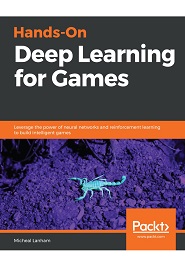
English | 2019 | ISBN: 978-1788994071 | 392 Pages | EPUB | 311 MB
Understand the core concepts of deep learning and deep reinforcement learning by applying them to develop games
The number of applications of deep learning and neural networks has multiplied in the last couple of years. Neural nets has enabled significant breakthroughs in everything from computer vision, voice generation, voice recognition and self-driving cars. Game development is also a key area where these techniques are being applied. This book will give an in depth view of the potential of deep learning and neural networks in game development.
We will take a look at the foundations of multi-layer perceptron’s to using convolutional and recurrent networks. In applications from GANs that create music or textures to self-driving cars and chatbots. Then we introduce deep reinforcement learning through the multi-armed bandit problem and other OpenAI Gym environments.
As we progress through the book we will gain insights about DRL techniques such as Motivated Reinforcement Learning with Curiosity and Curriculum Learning. We also take a closer look at deep reinforcement learning and in particular the Unity ML-Agents toolkit. By the end of the book, we will look at how to apply DRL and the ML-Agents toolkit to enhance, test and automate your games or simulations. Finally, we will cover your possible next steps and possible areas for future learning.
What you will learn
- Learn the foundations of neural networks and deep learning.
- Use advanced neural network architectures in applications to create music, textures, self driving cars and chatbots.
- Understand the basics of reinforcement and DRL and how to apply it to solve a variety of problems.
- Working with Unity ML-Agents toolkit and how to install, setup and run the kit.
- Understand core concepts of DRL and the differences between discrete and continuous action environments.
- Use several advanced forms of learning in various scenarios from developing agents to testing games.
Resolve the captcha to access the links!